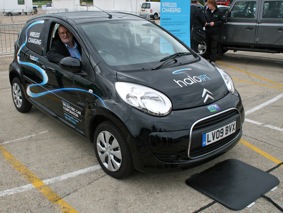 Thanks to a new wireless charging technology which promises to recharge a car’s battery while it is being driven this issues seems to become things of past in New Zeeland.
Thanks to a new wireless charging technology which promises to recharge a car’s battery while it is being driven this issues seems to become things of past in New Zeeland.
HaloIPT and engineering giant ARUP have developed a wireless charging system where cars simply position themselves above a charging pad rather than using a conventional plug just like a giant Scalextric.
Cars are fitted with a receiving pad can be charged via a magnetic field created using an advanced version of the Inductive Power Transfer (IPT) technology commonly found in electric toothbrushes. Electricity can be transferred over gaps as large as 400mm, meaning that recharging pads could feasibly be fitted beneath asphalt roads. Poor parkers can position their vehicles 250mm either side of the pad, which would then power up the car overnight without drivers having to remember to plug it in.
According to HaloIPT, pilot systems have been successfully tested on buses in Italy and Holland and do not cost any more than the plug-in equivalent. HaloIPT’s chief executive Dr Anthony Thomson said the company now aims to build a commercial-scale demonstration system by 2012. “This technology works in the bathroom, it works in the kitchen – we’re saying it can work in your garage,” he said at the UK launch of the technology last night. However, he added that in the longer term the range of the magnetic field meant it would be possible to place a series of pads under roads, allowing electric vehicles to refuel while on the move.
Potentially, this could extend the range of electrical cars far beyond the 100-mile limit currently experienced by most electric vehicles. It would also allow designers to decrease the size of the battery, reducing the weight of the car and leading to improved performance.
“By energising lanes you can reduce batteries to the point where the car just needs to get from your home to the highway,” Thomson said. “This resembles a shift to mobile phones and WiFi – we’re making it easier, simpler and safer to own and charge an electric vehicle.” However, he admitted that persuading car manufacturers of the benefits of the new technology would be crucial to its adoption, predicting that a large coalition of companies would be required to build the infrastructure necessary for dynamic charging.
Even so, David Martell, chief executive of the Electric Car Corporation from UK, predicted the technology could inspire a huge uptake in EVs.




Yawn! old as the hills and STILL not very efficient compared with plugging in a cable. Pioneered by Tesla before 1900.